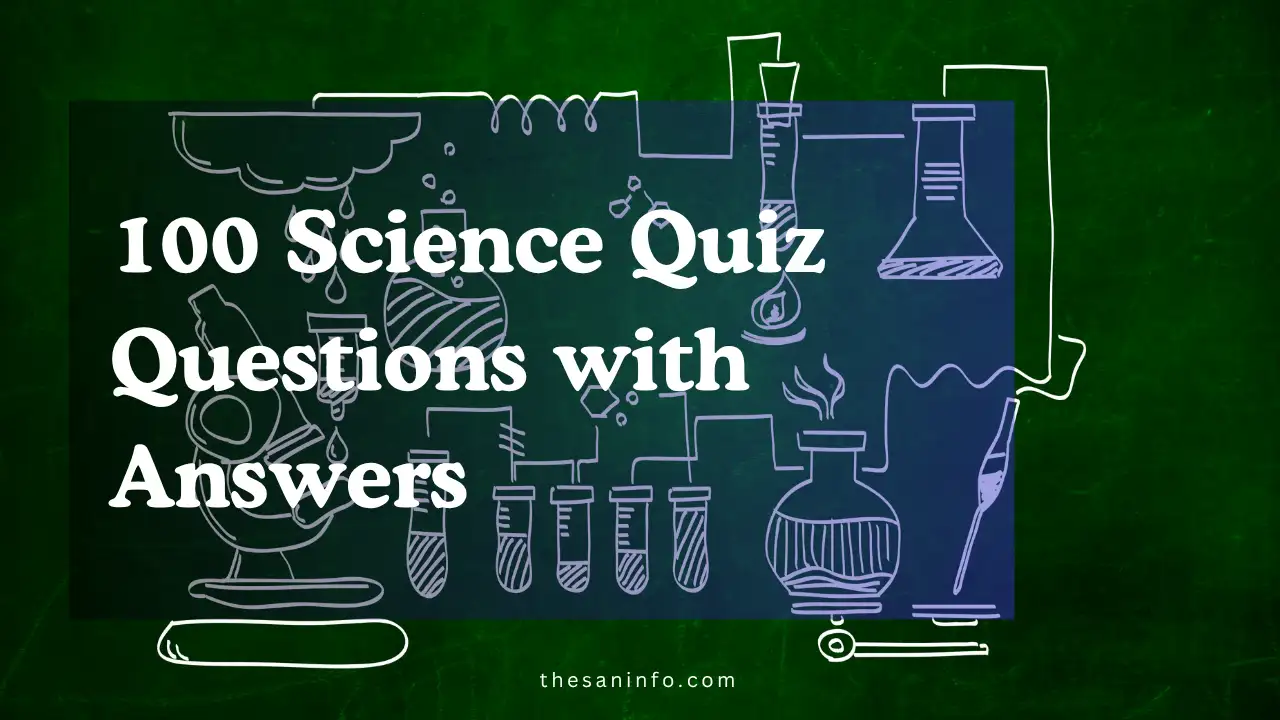100 Science Quiz Questions with Answers: Test Your Knowledge in 2026
What’s good, squad? San here, your millennial hype-man for all things hustle and brainpower. Science is the backbone of our world—from the tech in your phone to the biology of your late-night energy crash. In 2026, with STEM fields growing 10.5% by 2030 and science literacy more clutch than ever [ScienceDaily], I’m stoked to drop 100 science quiz questions with answers to test your smarts. Whether you’re hosting a game night, prepping for a trivia showdown, or just geeking out solo, these questions span physics, biology, chemistry, astronomy, and more. I’ve pulled from journals, NASA updates, and trivia pros to mix easy, medium, and hard questions, each with a quick explanation to make you a mini-expert. Let’s see how many you can crush—grab your crew and dive in!
Why Science Quizzes Are My Jam
Quizzes aren’t just fun—they’re a dope way to flex your brain. The global ed-tech market’s hitting $400 billion by 2027, with interactive learning like quizzes leading the charge [Forbes]. For us millennials, juggling side hustles and big dreams, staying sharp on science keeps us ahead, whether you’re coding apps or just curious about the universe. Plus, in 2026, with AI and climate tech trending, these questions tie into what’s hot. Here’s why this list slaps:
- All Levels, All Vibes: From “What’s gravity?” to quantum physics head-scratchers.
- Learn as You Go: Answers unpack the science, so you walk away smarter.
- 2025 Relevance: Questions hit trending topics like space missions and green energy [NASA].
- Party or Solo: Perfect for classrooms, Zoom hangouts, or late-night brain teasers.
100 Science Quiz Questions with Answers
I’ve split these into categories for easy navigation. Each question comes with an answer and a quick explanation to level up your knowledge. Let’s go!
Physics (20 Questions)
- What force keeps planets orbiting the Sun?
Answer: Gravity
Why: Gravity, described by Newton’s laws, pulls planets toward the Sun, balancing their motion to create orbits [NASA]. - What’s the speed of light in a vacuum?
Answer: 299,792,458 meters per second
Why: This constant (roughly 300,000 km/s) is the cosmic speed limit, per Einstein’s relativity. - What unit measures electrical resistance?
Answer: Ohm
Why: Named after Georg Ohm, it quantifies how materials resist electric current. - What’s the primary source of Earth’s energy?
Answer: The Sun
Why: Solar radiation drives weather, photosynthesis, and most energy systems. - What particle mediates the strong nuclear force?
Answer: Gluon
Why: Gluons “glue” quarks together inside protons and neutrons [ScienceDaily]. - What’s the formula for kinetic energy?
Answer: KE = ½ mv²
Why: Kinetic energy depends on mass (m) and velocity (v) squared. - What causes a rainbow?
Answer: Refraction and dispersion of light
Why: Water droplets split sunlight into colors by bending wavelengths differently. - What’s the SI unit of force?
Answer: Newton
Why: One newton accelerates a 1-kg mass by 1 m/s². - What’s the law of conservation of energy?
Answer: Energy cannot be created or destroyed, only transferred
Why: A fundamental physics principle, seen in everything from engines to stars. - What’s the main source of Earth’s magnetic field?
Answer: Molten iron in the outer core
Why: Its movement generates electric currents, creating the field. - What’s the name of the effect where light bends around massive objects?
Answer: Gravitational lensing
Why: Predicted by Einstein, seen in galaxy clusters bending starlight. - What’s the primary particle in an atom’s nucleus?
Answer: Proton and neutron
Why: Protons define the element; neutrons stabilize the nucleus. - What’s the term for energy stored in an object due to position?
Answer: Potential energy
Why: Think a stretched spring or water behind a dam. - What’s the frequency range of visible light?
Answer: 400–700 nanometers
Why: These wavelengths create the colors we see. - What’s the first law of thermodynamics?
Answer: Energy is conserved in a closed system
Why: Total energy remains constant, just changes form. - What particle carries electric charge in a wire?
Answer: Electron
Why: Electrons flow to create current in conductors. - What’s the name of the force opposing motion between surfaces?
Answer: Friction
Why: It’s why your shoes grip the floor or brakes stop a car. - What’s the Heisenberg Uncertainty Principle?
Answer: You can’t know a particle’s position and momentum exactly at the same time
Why: A quantum rule shaping modern physics. - What’s the primary source of cosmic background radiation?
Answer: Big Bang
Why: Leftover heat from the universe’s birth, detected today. - What’s the unit of power?
Answer: Watt
Why: One watt equals one joule per second of energy transfer.
Biology (20 Questions)
- What gas do plants absorb to make food?
Answer: Carbon dioxide
Why: Used in photosynthesis to produce glucose with sunlight. - What’s the powerhouse of the cell?
Answer: Mitochondrion
Why: It produces ATP, the cell’s energy currency. - What molecule carries genetic information?
Answer: DNA
Why: Deoxyribonucleic acid stores instructions for life. - What’s the process by which plants make food?
Answer: Photosynthesis
Why: Converts sunlight, CO₂, and water into glucose and oxygen. - What’s the human body’s largest organ?
Answer: Skin
Why: It protects, regulates temperature, and senses touch. - What’s the primary function of red blood cells?
Answer: Carry oxygen
Why: Hemoglobin binds oxygen for transport to tissues. - What’s the name of the process where cells divide to form gametes?
Answer: Meiosis
Why: Creates sperm/egg cells with half the chromosomes. - What’s the main source of energy for Earth’s climate?
Answer: Solar radiation
Why: Drives weather patterns and ocean currents. - What’s the term for an organism’s role in its ecosystem?
Answer: Niche
Why: Describes how it interacts with resources and other species. - What’s the primary pigment in photosynthesis?
Answer: Chlorophyll
Why: Absorbs light to kickstart energy production. - What’s the name of the protein that carries oxygen in blood?
Answer: Hemoglobin
Why: Binds oxygen in lungs, releases it in tissues. - What’s the process of cell division for growth?
Answer: Mitosis
Why: Creates two identical daughter cells for repair/growth. - What’s the term for a community of living organisms and their environment?
Answer: Ecosystem
Why: Includes biotic (living) and abiotic (non-living) components. - What’s the primary source of genetic variation?
Answer: Mutation
Why: Random DNA changes drive evolution. - What’s the name of the molecule that stores energy in cells?
Answer: ATP
Why: Adenosine triphosphate powers cellular processes. - What’s the main function of the nervous system?
Answer: Transmit signals
Why: Coordinates body actions via neurons. - What’s the term for organisms that make their own food?
Answer: Autotroph
Why: Plants and algae produce energy via photosynthesis. - What’s the primary component of cell membranes?
Answer: Phospholipids
Why: Form a bilayer that controls what enters/leaves cells. - What’s the name of the process where water moves through plants?
Answer: Transpiration
Why: Pulls water from roots to leaves, aiding nutrient flow. - What’s the human body’s normal temperature in Celsius?
Answer: 37°C
Why: Optimal for metabolic processes.
Chemistry (20 Questions)
- What’s the most abundant element in the universe?
Answer: Hydrogen
Why: Makes up ~75% of all matter, fueling stars [NASA]. - What’s the chemical symbol for gold?
Answer: Au
Why: From the Latin “aurum,” it’s a precious metal. - What’s the pH of pure water?
Answer: 7
Why: Neutral, balancing acids and bases. - What gas, discovered on the Sun before Earth, is second-most abundant in the universe?
Answer: Helium
Why: Forms in stars via fusion, inert on Earth. - What’s the process of splitting atoms to release energy?
Answer: Nuclear fission
Why: Powers nuclear reactors and weapons. - What’s the main component of natural gas?
Answer: Methane
Why: CH₄ is a potent energy source. - What’s the chemical formula for table salt?
Answer: NaCl
Why: Sodium and chloride ions form a crystal lattice. - What’s the term for a substance that speeds up a chemical reaction?
Answer: Catalyst
Why: Lowers activation energy without being consumed. - What’s the primary gas in Earth’s atmosphere?
Answer: Nitrogen
Why: ~78% of air, mostly inert. - What’s the name of the bond where electrons are shared?
Answer: Covalent bond
Why: Common in molecules like water (H₂O). - What’s the atomic number of carbon?
Answer: 6
Why: Six protons define carbon’s place on the periodic table. - What’s the process of a solid turning directly into a gas?
Answer: Sublimation
Why: Seen in dry ice (CO₂) at room temperature. - What’s the main element in organic compounds?
Answer: Carbon
Why: Its ability to form chains drives life’s chemistry. - What’s the name of the reaction that releases heat?
Answer: Exothermic
Why: Think combustion or explosions. - What’s the chemical formula for water?
Answer: H₂O
Why: Two hydrogen atoms bond with one oxygen. - What’s the term for a solution with excess hydrogen ions?
Answer: Acid
Why: pH below 7, like lemon juice. - What’s the primary source of energy in fossil fuels?
Answer: Chemical bonds
Why: Burning releases stored energy as heat. - What’s the name of the gas that causes the greenhouse effect?
Answer: Carbon dioxide
Why: Traps heat, warming the planet. - What’s the process of combining elements to form compounds?
Answer: Chemical reaction
Why: Rearranges atoms to form new substances. - What’s the term for equal concentrations in a solution?
Answer: Equilibrium
Why: Reactions balance forward and reverse rates.
Astronomy & Earth Science (20 Questions)
- What’s the closest planet to the Sun?
Answer: Mercury
Why: Orbits at ~58 million km from the Sun [NASA]. - What’s the largest planet in our solar system?
Answer: Jupiter
Why: Its diameter is ~140,000 km, 11x Earth’s. - What’s the primary source of Earth’s tides?
Answer: Moon’s gravity
Why: Pulls oceans, causing daily tides. - What’s the name of our galaxy?
Answer: Milky Way
Why: A barred spiral galaxy housing our solar system. - What’s the hottest layer of Earth’s atmosphere?
Answer: Thermosphere
Why: Absorbs solar radiation, reaching 2,000°C. - What’s the primary rock type in Earth’s crust?
Answer: Igneous
Why: Forms from cooled magma, like granite. - What’s the name of the closest star to Earth?
Answer: Proxima Centauri
Why: At 4.24 light-years, it’s part of the Alpha Centauri system. - What’s the process powering the Sun?
Answer: Nuclear fusion
Why: Hydrogen fuses into helium, releasing energy. - What’s the term for a star’s explosive end?
Answer: Supernova
Why: Massive stars collapse, creating heavy elements. - What’s the primary cause of Earth’s seasons?
Answer: Axial tilt
Why: Earth’s 23.5° tilt changes sunlight intensity. - What’s the name of Mars’ largest volcano?
Answer: Olympus Mons
Why: Largest in the solar system, ~22 km high. - What’s the primary gas in Venus’ atmosphere?
Answer: Carbon dioxide
Why: ~96%, causing extreme greenhouse effects. - What’s the term for a rock from space hitting Earth?
Answer: Meteorite
Why: Meteors burn up; meteorites reach the surface. - What’s the main source of auroras?
Answer: Solar wind
Why: Charged particles hit Earth’s magnetic field. - What’s the name of Jupiter’s largest moon?
Answer: Ganymede
Why: Larger than Mercury, it has its own magnetic field. - What’s the primary cause of earthquakes?
Answer: Tectonic plate movement
Why: Plates shift, releasing energy along faults. - What’s the term for a star that suddenly brightens?
Answer: Nova
Why: Caused by fusion on a white dwarf’s surface. - What’s the main component of Earth’s core?
Answer: Iron
Why: With nickel, it generates the magnetic field. - What’s the name of the boundary between Earth’s crust and mantle?
Answer: Mohorovičić discontinuity (Moho)
Why: Marks a density shift in Earth’s layers. - What’s the primary source of lunar craters?
Answer: Meteoroid impacts
Why: No atmosphere means no protection from impacts.
General Science & Technology (20 Questions)
- What’s the primary source of renewable energy in 2025?
Answer: Solar power
Why: Accounts for 40% of renewable growth [Forbes]. - What’s the name of the first human-made object in space?
Answer: Sputnik 1
Why: Launched by the USSR in 1957. - What’s the main material in computer chips?
Answer: Silicon
Why: Its semiconductor properties power electronics. - What’s the term for a self-sustaining nuclear reaction?
Answer: Chain reaction
Why: Neutrons trigger more fissions, releasing energy. - What’s the primary goal of CRISPR technology?
Answer: Gene editing
Why: Allows precise DNA modifications [ScienceDaily]. - What’s the name of the rover exploring Mars in 2025?
Answer: Perseverance
Why: Launched in 2020, still collecting samples [NASA]. - What’s the main source of ocean acidification?
Answer: Carbon dioxide absorption
Why: Forms carbonic acid, lowering pH. - What’s the term for AI that mimics human thinking?
Answer: Artificial General Intelligence (AGI)
Why: Aims to match human versatility, still in development. - What’s the primary fuel for nuclear fusion experiments?
Answer: Hydrogen isotopes (deuterium, tritium)
Why: Fuse to form helium, releasing energy. - What’s the name of the largest particle accelerator?
Answer: Large Hadron Collider
Why: At CERN, it probes fundamental particles. - What’s the main source of global warming?
Answer: Greenhouse gases
Why: CO₂, methane trap heat, raising temperatures. - What’s the term for a substance that conducts electricity under certain conditions?
Answer: Semiconductor
Why: Used in solar panels and chips. - What’s the primary source of geothermal energy?
Answer: Earth’s internal heat
Why: From radioactive decay and core formation. - What’s the name of the first cloned mammal?
Answer: Dolly the sheep
Why: Cloned in 1996 via nuclear transfer. - What’s the main component of air pollution?
Answer: Particulate matter
Why: Tiny particles harm health and visibility. - What’s the term for a sudden genetic change?
Answer: Mutation
Why: Can lead to evolution or disease. - What’s the primary source of tidal energy?
Answer: Moon’s gravitational pull
Why: Drives tidal movements for power. - What’s the name of the telescope launched in 2021 to replace Hubble?
Answer: James Webb Space Telescope
Why: Observes infrared, revealing distant galaxies [NASA]. - What’s the main goal of quantum computing?
Answer: Solve complex problems faster
Why: Uses quantum bits (qubits) for massive parallelism. - What’s the term for Earth’s protective ozone layer?
Answer: Stratosphere ozone
Why: Absorbs harmful UV radiation.
How to Use This Quiz
- Game Night: Split into teams, use a timer, and award points (1 for easy, 2 for medium, 3 for hard).
- Classroom: Teachers, assign sections (e.g., biology) for group discussions.
- Solo Challenge: Time yourself—aim for 80+ correct to claim science nerd status.
- Level Up: Research wrong answers using the citations for deeper dives.
Challenges & Pro Tips
Some questions (like quantum physics) are tough—don’t sweat it! The brain’s prefrontal cortex (yep, from my last post) loves a challenge, boosting dopamine when you nail a hard one [Scientific American]. If you’re stuck, use mnemonic tricks (e.g., “H₂O” for water) or group study to spark ideas. In 2025, with STEM hype peaking, this quiz keeps you sharp for trivia nights or even job interviews.
San’s Final Take
Yo, San’s squad—this quiz is your ticket to flexing science smarts while having a blast. I had fun digging into NASA reports and journals to craft this, and I’m betting you’ll ace at least 50. Try it, share your score in the comments, and tag a friend who thinks they’re the Einstein of the group. What’s your fave science topic? Let’s geek out together!
Key Citations:






